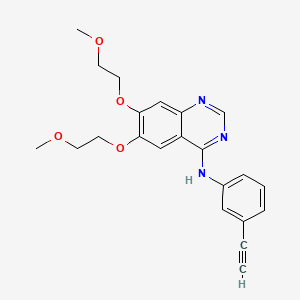D0470 | erlotinib
L
L01XE03 Erlotinib
[L01XE] Protein kinase inhibitors
[L01X] OTHER ANTINEOPLASTIC AGENTS
[L01] ANTINEOPLASTIC AGENTS
[L] Antineoplastic and immunomodulating agents
| Toxicity | Dose | Time | Species | Model | Method | Action | Positive criterion | Reference |
|---|---|---|---|---|---|---|---|---|
| UNCOUPLING | increase | 36 | ||||||
| MEMBRANE POTENTIAL | 195.9 µM | 30 mins | mouse | liver mitochondria | Rh123 fluorescence (excitation 485 nm, emission 535 nm) are recorded using a fluorescence multi-well plate reader (mCICCP (20 µM) treatments was considered as the 100% baseline for ΔΨm loss) | decrease | EC20 | 36 |
| RESPIRATION | 328.8 µM | 60 mins | mouse | liver mitochondria | Oxygen consumption was monitored with 50nM MitoXpress ( an oxygen-sensitive phosphorescent dye) using a spectrofluorimeter (Tecan Infinite 200; λExcitation 380nm; λEmission 650nm). Rotenone (2µM) was used as 100% baseline for complex I inhibition. | decrease | EC20 | 36 |
| RESPIRATION | 17.4 µM | 60 mins | mouse | liver mitochondria | Oxygen consumption was monitored with 50nM MitoXpress ( an oxygen-sensitive phosphorescent dye) using a spectrofluorimeter (Tecan Infinite 200; λExcitation 380nm; λEmission 650nm). Oligomycin A (1µM) was used as 100% baseline for complex II inhibition. | increase | EC20 | 36 |
| SWELLING | ND | 30 mins | mouse | liver mitochondria | swelling assay: Absorbance at 545 nm using a fluorescence multi-well plate reader (CaCl2 (50 µM) was considered as the 100% baseline for the swelling ) | Negative | EC20 | 36 |
| Target | Dose | Time | Species | Model | Method | Action | Positive criterion | Reference |
|---|---|---|---|---|---|---|---|---|
| NADH:ubiquinone reductase | 328.8 µM | 60 mins | mouse | liver mitochondria | Oxygen consumption was monitored with 50nM MitoXpress ( an oxygen-sensitive phosphorescent dye) using a spectrofluorimeter (Tecan Infinite 200; λExcitation 380nm; λEmission 650nm). Rotenone (2µM) was used as 100% baseline for complex I inhibition. | inhibit | EC20 | 36 |
| Cytochrome c | 30 mins | mouse | liver mitochondria | Cytochrome c release was evaluated using ELISA kit ( 20 µg/ml Alamethicin was used as 100% baseline) | Negative | EC20 | 36 | |
| Pictogram | Signal | Statements | Precautionary Statement Codes |
|---|---|---|---|
   |
Warning |
Aggregated GHS information provided by 11 companies from 3 notifications to the ECHA C&L Inventory. Each notification may be associated with multiple companies. H302 (18.18%): Harmful if swallowed [Warning Acute toxicity, oral] H351 (81.82%): Suspected of causing cancer [Warning Carcinogenicity] H411 (18.18%): Toxic to aquatic life with long lasting effects [Hazardous to the aquatic environment, long-term hazard] H413 (81.82%): May cause long lasting harmful effects to aquatic life [Hazardous to the aquatic environment, long-term hazard] Information may vary between notifications depending on impurities, additives, and other factors. The percentage value in parenthesis indicates the notified classification ratio from companies that provide hazard codes. Only hazard codes with percentage values above 10% are shown. |
P201, P202, P264, P270, P273, P281, P301+P312, P308+P313, P330, P391, P405, and P501; (The corresponding statement to each P-code can be found at the GHS Classification page.) |
| 134172-EP2292233A2 | 15214-EP2269994A1 | 15214-EP2272827A1 |
| 15214-EP2281815A1 | 15214-EP2292234A1 | 15214-EP2292615A1 |
| 15214-EP2295432A1 | 15214-EP2298778A1 | 15214-EP2301533A1 |
| 15214-EP2301933A1 | 15214-EP2305640A2 | 15214-EP2305671A1 |
| 15214-EP2305687A1 | 15214-EP2308855A1 | 15214-EP2311827A1 |
| 15214-EP2311840A1 | 15214-EP2311842A2 | 15214-EP2316832A1 |
| 15214-EP2316833A1 | 183321-74-6 | 321E746 |
| 32334-EP2281815A1 | 32334-EP2292615A1 | 32334-EP2301933A1 |
| 32334-EP2305640A2 | 32334-EP2305671A1 | 32334-EP2311827A1 |
| 3615AH | 4-Quinazolinamine, N-(3-ethynylphenyl)-6,7-bis(2-methoxyethoxy)- | 4-[(3-Ethynylphenyl)amino]-6,7-bis(2-methoxyethoxy)quinazoline |
| 4-[(3-ethynylphenyl)amino]-6,7-bis(2-methoxyethoxy)quinazoline | A11416 | AAKJLRGGTJKAMG-UHFFFAOYSA-N |
| AB0017012 | AB01273955-01 | AB01273955-02 |
| AB01273955-03 | AB1004620 | AC-399 |
| AK142763 | AKOS000282911 | AM20090621 |
| AMX10161 | API0024668 | AS-35132 |
| BCB03_000783 | BDBM5446 | BIFK0019 |
| BRD-K70401845-003-04-7 | CAS-183321-74-6 | CCG-220420 |
| CHEBI:114785 | CHEMBL553 | CP-358,774 |
| CP-35877401 | CP358774 | CS-0620 |
| DB00530 | DSSTox_CID_26454 | DSSTox_GSID_46454 |
| DSSTox_RID_81628 | DTXSID8046454 | EN002711 |
| Erlotinib | Erlotinib Base; | Erlotinib [INN:BAN] |
| Erlotinib free base | Erlotinib(Tarceva) | Erlotinib, OS-774 |
| Erlotinin | Erotinib | FT-0083688 |
| FT-0651539 | GTPL4920 | HMS2089F05 |
| HMS3244M19 | HMS3244M20 | HMS3244N19 |
| HMS3713C22 | HMS3745M05 | HSDB 8082 |
| HY-50896 | J4T82NDH7E | K00241 |
| KS-00000642 | Kinome_3317 | LS-184395 |
| MCULE-7764565391 | N-(3-Ethynylphenyl)-6,7-bis(2-methoxyethoxy)-4-quinazolinamine | N-(3-Ethynylphenyl)-6,7-bis(2-methoxyethoxy)quinazolin-4-amine |
| N-(3-ethynylphenyl)-6,7-bis(2-methoxyethoxy)-4-Quinazolinamine | NCGC00164574-01 | NCGC00164574-03 |
| NCGC00164574-05 | NCGC00164574-06 | NCGC00164574-14 |
| NSC 718781 | NSC718781 | OSI 744 |
| OSI-744 | OSI-774 | P443 |
| Q418369 | QCR-100 | QUI124 |
| R 1415 | R-1415 | RG-1415 |
| Ro-508231 | S-7717 | SB16916 |
| SCHEMBL8413 | SR-05000001460 | SR-05000001460-1 |
| SR-05000001460-2 | SR-05000001460-3 | SR-05000001460-6 |
| ST24046689 | STK623143 | SY028059 |
| Tox21_112202 | Tox21_112202_1 | UNII-J4T82NDH7E |
| ZINC1546066 | ZX-AFC000128 | [6,7-BIS(2-METHOXY-ETHOXY)QUINAZOLINE-4-YL]-(3-ETHYNYLPHENYL)AMINE |
| [6,7-Bis-(2-methoxy-ethoxy)-quinazolin-4-yl]-(3-ethynyl-phenyl)-amine | cid_176870 | erlotinibum |
| n-(3-ethynylphenyl)-6,7-bis(2-methoxyethoxy)-4-quinazolinamine monohydrochloride | n-(3-ethynylphenyl)[6,7-bis(2-methoxyethoxy)quinazolin-4-yl]amine | nchembio866-comp3 |
| s7786 |

